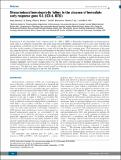| dc.contributor.author | Ramsey, Haley | |
| dc.contributor.author | Zhang, Qi | |
| dc.contributor.author | Brown, Diane E. | |
| dc.contributor.author | Steensma, David P. | |
| dc.contributor.author | Lin, Charles | |
| dc.contributor.author | Wu, Mei X. | |
| dc.date.accessioned | 2014-05-29T19:13:47Z | |
| dc.date.available | 2014-05-29T19:13:47Z | |
| dc.date.issued | 2013-09 | |
| dc.date.submitted | 2013-05 | |
| dc.identifier.issn | 0390-6078 | |
| dc.identifier.issn | 1592-8721 | |
| dc.identifier.uri | http://hdl.handle.net/1721.1/87577 | |
| dc.description.abstract | Expression of the immediate early response gene X-1 (IEX-1, IER3) is diminished significantly in hematopoietic stem cells in a subgroup of patients with early stage myelodysplastic syndromes, but it is not clear whether the deregulation contributes to the disease. The current study demonstrates increased apoptosis and a concomitant decrease in the number of hematopoietic stem cells lacking this early response gene. Null mutation of the gene also impeded platelet differentiation and shortened a lifespan of red blood cells. When bone marrow cells deficient in the gene were transplanted into wild-type mice, the deficient stem cells produced significantly fewer circulating platelets and red blood cells, despite their enhanced repopulation capability. Moreover, after exposure to a non-myeloablative dose of radiation, absence of the gene predisposed to thrombocytopenia, a significant decline in red blood cells, and dysplastic bone marrow morphology, typical characteristics of myelodysplastic syndromes. These findings highlight a previously unappreciated role for this early response gene in multiple differentiation steps within hematopoiesis, including thrombopoiesis, erythropoiesis and in the regulation of hematopoietic stem cell quiescence. The deficient mice offer a novel model for studying the initiation and progression of myelodysplastic syndromes as well as strategies to prevent this disorder. | en_US |
| dc.description.sponsorship | National Institutes of Health (U.S.) (Grant CA158756) | en_US |
| dc.description.sponsorship | National Institutes of Health (U.S.) (Grant AI089779) | en_US |
| dc.description.sponsorship | National Institutes of Health (U.S.) (Grant DA028378) | en_US |
| dc.description.sponsorship | National Institutes of Health (U.S.) (Grant HL097748) | en_US |
| dc.language.iso | en_US | |
| dc.publisher | Ferrata Storti Foundation | en_US |
| dc.relation.isversionof | http://dx.doi.org/10.3324/haematol.2013.092452 | en_US |
| dc.rights | Creative Commons Attribution | en_US |
| dc.rights.uri | http://creativecommons.org/licenses/by/3.0/ | en_US |
| dc.source | Ferrata Storti Foundation | en_US |
| dc.title | Stress-induced hematopoietic failure in the absence of immediate early response gene X-1 (IEX-1, IER3) | en_US |
| dc.type | Article | en_US |
| dc.identifier.citation | Ramsey, H., Q. Zhang, D. E. Brown, D. P. Steensma, C. P. Lin, and M. X. Wu. “Stress-Induced Hematopoietic Failure in the Absence of Immediate Early Response Gene X-1 (IEX-1, IER3).” Haematologica 99, no. 2 (February 1, 2014): 282–291. © Ferrata Storti Foundation | en_US |
| dc.contributor.department | Harvard University--MIT Division of Health Sciences and Technology | en_US |
| dc.contributor.mitauthor | Lin, Charles | en_US |
| dc.contributor.mitauthor | Wu, Mei X. | en_US |
| dc.relation.journal | Haematologica | en_US |
| dc.eprint.version | Final published version | en_US |
| dc.type.uri | http://purl.org/eprint/type/JournalArticle | en_US |
| eprint.status | http://purl.org/eprint/status/PeerReviewed | en_US |
| dspace.orderedauthors | Ramsey, H.; Zhang, Q.; Brown, D. E.; Steensma, D. P.; Lin, C. P.; Wu, M. X. | en_US |
| dspace.mitauthor.error | true | |
| mit.license | PUBLISHER_CC | en_US |
| mit.metadata.status | Complete | |
